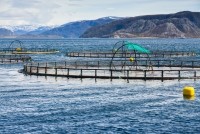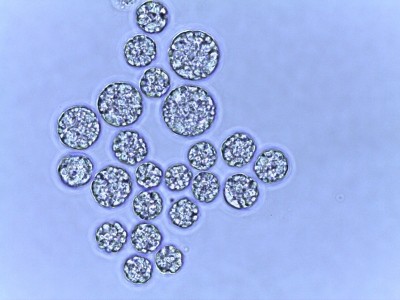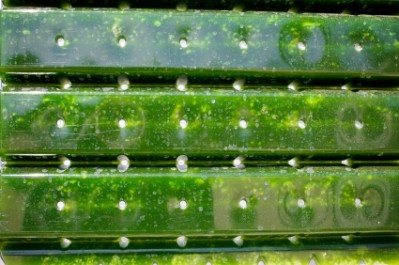Skretting gets behind algal oil breakthrough from Evonik and DSM

As global supplies of fish oil remain static or decline and demand for aqua feed grows over the next decade, so too does the need to find alternative sources of Eicosapentaenoic acid (EPA) and docosahexaenoic acid (DHA) for use in salmon and trout diets.
Evy Vikene, manager special projects at Skretting, told us the algal oil is an industry first. "It provides both microalgae derived DHA and EPA, the only fish oil alternative on the market to do so, with both of those nutrients in high concentrations. Also, it is the only fish oil fatty acid replacement, so far, that is delivered as an oil. And it is much better to add oil to a feed than biomass, from a nutritional perspective."
She said there is not the urgency right now to supply alternatives to fish oil as current supply meets industry demand. However, if the salmon sector grows as it is predicted to do, then alternatives are needed and Skretting wants to ensure such products will be able to meet the need of the industry in terms of scale and performance.
Meaningful volumes of the algae oil are available now, but commercial scale up to meet future demand is being investigated. "We have to make sure we will be ready," said Vikene.
The oil is being produced at DSM's plant in South Carolina, in the US.
Digestibility trials
As a joint partner in the project with DSM and Evonik, she said Skretting tested the marine microalgae oil in terms of digestibility, absorption, fish health and growth. "It is equivalent to fish oil in terms of digestibility, and we saw that the DHA and EPA is fully absorbed," said Vikene.
The algal oil is approved for use in the EU, added the fish feed manufacturer.
One of the critical findings in the DSM and Evonik collaborative research effort was the identification of naturally occurring marine algae that contains both fatty acids, said Skretting. "It is a great sustainability story. The marine food chain is bypassed as the microalgae is sourced from the marine environment, and then grown in a land based production system," said Vikene.

Skretting is a long term partner of DSM and Evonik, companies that supply it with pigments, vitamins and amino acids, respectively. "But we don't have an exclusive arrangement with DSM and Evonik in terms of supply of the algal oil," she added.
Skretting is also an associate member of the global salmon initiative (GSI), which aims at working with potential suppliers of novel oils rich in DHA and EPA to help supplement current fish oil use and to integrate these oils into the supply chain as soon as possible.
Industry innovation
Up until very recently, almost 70% of fish oil in salmon diets was being replaced by vegetable derived oils such as rapeseed oil, or with poultry oil in the case of the Americas and Asia. But a huge amount of investigation has been underway in the past few years in the area of microalgae derived DHA and EPA sources.
But while some research efforts would seem to have delivered on the DHA replacement side, substitutes for fish oil derived EPA had been lacking, until now.
Earlier this year Danish fish feed group, BioMar, announced it was launching a fish feed containing marine fatty acids from microalgae, with high DHA levels, developed through the Bunge Limited and TerraVia research collaboration.
The algae derived product is produced at Bunge and TerraVia’s joint venture renewable oils manufacturing plant in Brazil.
The DHA levels in the feed ingredient are about twice the levels of what can be found in fish oil, Graham Ellis, senior vice president business development and strategic accounts, at TerraVia, told us in May.
Full-scale production of the feed ingredient was completed at the end of 2015.
And Archer Daniels Midland (ADM) also launched a 'DHA rich' alternative to fish oil sourced long chain omega-3 in June.
The initial target for DHA Natur is the aquaculture industry and the move is part of an effort to increase ADM’s presence in that sector, Peter Bergstrom, international business manager for ADM Animal Nutrition, told this publication previously.
The algae biomass needed to produce DHA Natur is being generated through a heterotrophic fermentation process at the company’s facility in Clinton, Iowa, he explained. That plant has in built production flexibility, allowing for capacity expansion depending on global demand.
“As a sustainably produced DHA source that is derived from algae, DHA Natur provides an important solution for the aquaculture industry, and we see a lot of growth potential in this market,” he said.
He said the product could, potentially, also be used with other species including poultry and swine or dairy cattle.
The product includes about 17-20% DHA mixed with a meal product, said the company.
“Our strain of DHA compares well with various types of fish oil,” said Bergstrom. “The product contains high consistent levels of DHA, which is a benefit. It is also plant-based and made in a sustainable manufacturing process.”
This article was amended on Tuesday 4 October to take account of comments from Skretting.












